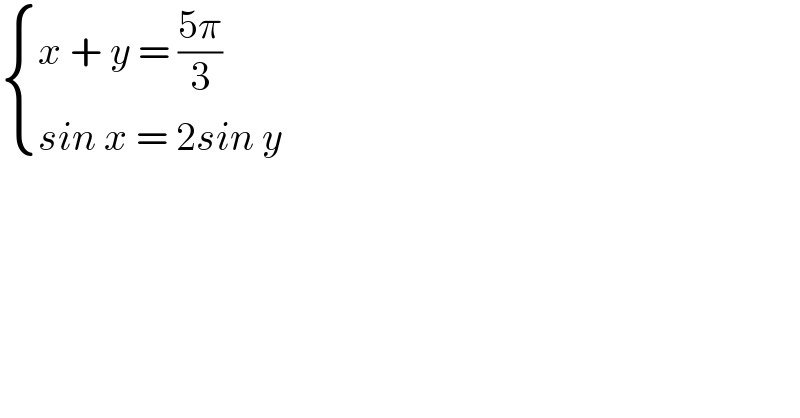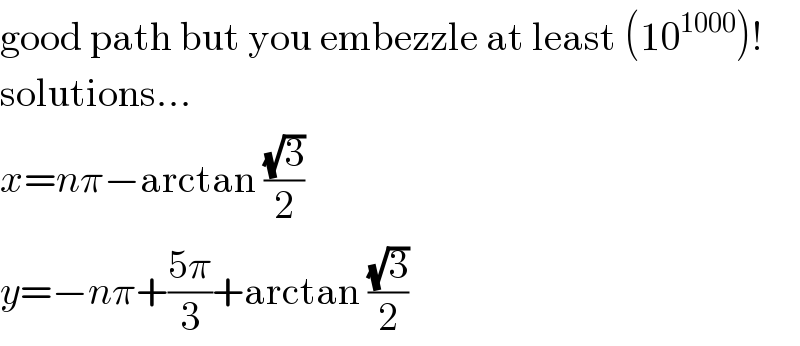Question Number 125359 by weltr last updated on 10/Dec/20

$$\begin{cases}{{x}\:+\:{y}\:=\:\frac{\mathrm{5}\pi}{\mathrm{3}}}\\{{sin}\:{x}\:=\:\mathrm{2}{sin}\:{y}}\end{cases} \\ $$
Answered by Ar Brandon last updated on 10/Dec/20
![{ ((x+y=((5π)/3)),(...(i))),((sinx=2siny),(...(ii))) :} From (i), x+y=((5π)/3) ⇒ y=((5π)/3)−x substituting the above result in (ii) we have ; sinx=2sin(((5π)/3)−x)=2sin(π+(((2π)/3)−x))=2sin(x−((2π)/3)) {sin(π+x)=−sinx=sin(−x)} =2[sin(x)cos(((2π)/3))−cos(x)sin(((2π)/3))] =2[−(1/2)sinx−((√3)/2)cosx]=−sinx−(√3)cosx ⇒2sinx=−(√3)cosx ⇒ tanx=−((√3)/2) x=tan^(−1) (−((√3)/2)) , y=((5π)/3)−tan^(−1) (−((√3)/2))](https://www.tinkutara.com/question/Q125361.png)
$$\begin{cases}{\mathrm{x}+\mathrm{y}=\frac{\mathrm{5}\pi}{\mathrm{3}}}&{…\left(\mathrm{i}\right)}\\{\mathrm{sinx}=\mathrm{2siny}}&{…\left(\mathrm{ii}\right)}\end{cases} \\ $$$$\mathrm{From}\:\left(\mathrm{i}\right),\:\mathrm{x}+\mathrm{y}=\frac{\mathrm{5}\pi}{\mathrm{3}}\:\Rightarrow\:\mathrm{y}=\frac{\mathrm{5}\pi}{\mathrm{3}}−\mathrm{x} \\ $$$$\mathrm{substituting}\:\mathrm{the}\:\mathrm{above}\:\mathrm{result}\:\mathrm{in}\:\left(\mathrm{ii}\right)\:\mathrm{we}\:\mathrm{have}\:; \\ $$$$\mathrm{sinx}=\mathrm{2sin}\left(\frac{\mathrm{5}\pi}{\mathrm{3}}−\mathrm{x}\right)=\mathrm{2sin}\left(\pi+\left(\frac{\mathrm{2}\pi}{\mathrm{3}}−\mathrm{x}\right)\right)=\mathrm{2sin}\left(\mathrm{x}−\frac{\mathrm{2}\pi}{\mathrm{3}}\right) \\ $$$$\:\:\:\:\:\:\:\:\:\:\:\left\{{sin}\left(\pi+{x}\right)=−{sinx}={sin}\left(−{x}\right)\right\} \\ $$$$\:\:\:\:\:\:\:\:\:=\mathrm{2}\left[\mathrm{sin}\left(\mathrm{x}\right)\mathrm{cos}\left(\frac{\mathrm{2}\pi}{\mathrm{3}}\right)−\mathrm{cos}\left(\mathrm{x}\right)\mathrm{sin}\left(\frac{\mathrm{2}\pi}{\mathrm{3}}\right)\right] \\ $$$$\:\:\:\:\:\:\:\:\:=\mathrm{2}\left[−\frac{\mathrm{1}}{\mathrm{2}}\mathrm{sinx}−\frac{\sqrt{\mathrm{3}}}{\mathrm{2}}\mathrm{cosx}\right]=−\mathrm{sinx}−\sqrt{\mathrm{3}}\mathrm{cosx} \\ $$$$\Rightarrow\mathrm{2sinx}=−\sqrt{\mathrm{3}}\mathrm{cosx}\:\Rightarrow\:\mathrm{tanx}=−\frac{\sqrt{\mathrm{3}}}{\mathrm{2}} \\ $$$$\mathrm{x}=\mathrm{tan}^{−\mathrm{1}} \left(−\frac{\sqrt{\mathrm{3}}}{\mathrm{2}}\right)\:,\:\mathrm{y}=\frac{\mathrm{5}\pi}{\mathrm{3}}−\mathrm{tan}^{−\mathrm{1}} \left(−\frac{\sqrt{\mathrm{3}}}{\mathrm{2}}\right) \\ $$
Commented by MJS_new last updated on 10/Dec/20

$$\mathrm{good}\:\mathrm{path}\:\mathrm{but}\:\mathrm{you}\:\mathrm{embezzle}\:\mathrm{at}\:\mathrm{least}\:\left(\mathrm{10}^{\mathrm{1000}} \right)! \\ $$$$\mathrm{solutions}… \\ $$$${x}={n}\pi−\mathrm{arctan}\:\frac{\sqrt{\mathrm{3}}}{\mathrm{2}} \\ $$$${y}=−{n}\pi+\frac{\mathrm{5}\pi}{\mathrm{3}}+\mathrm{arctan}\:\frac{\sqrt{\mathrm{3}}}{\mathrm{2}} \\ $$
Commented by Ar Brandon last updated on 10/Dec/20
������
Commented by Ar Brandon last updated on 10/Dec/20
Thanks majesty ��
Commented by Ar Brandon last updated on 10/Dec/20
mjs, I meant ����
Commented by Ar Brandon last updated on 10/Dec/20
Extend my greetings to her majesty Sir �� Tell her I miss her so much����
Commented by Dwaipayan Shikari last updated on 10/Dec/20
you can't tell that you have told
Commented by Ar Brandon last updated on 10/Dec/20
tell, told, till����
Commented by Dwaipayan Shikari last updated on 10/Dec/20
�� ����
Commented by Ar Brandon last updated on 10/Dec/20
��I prefer this��
Commented by Ar Brandon last updated on 10/Dec/20
শুভ দিন��
Commented by Dwaipayan Shikari last updated on 10/Dec/20
হো
Answered by Dwaipayan Shikari last updated on 10/Dec/20

$$\frac{{sinx}+{siny}}{{sinx}−{cosy}}=\mathrm{3}\Rightarrow\frac{{tan}\left(\frac{{x}+{y}}{\mathrm{2}}\right)}{{tan}\left(\frac{{x}−{y}}{\mathrm{2}}\right)}=\mathrm{3}\Rightarrow{tan}\left(\frac{{x}−{y}}{\mathrm{2}}\right)=−\frac{\mathrm{1}}{\mathrm{3}\sqrt{\mathrm{3}}} \\ $$$${x}−{y}=\mathrm{2}{k}\pi−{tan}^{−\mathrm{1}} \frac{\mathrm{1}}{\mathrm{3}\sqrt{\mathrm{3}}} \\ $$$${x}=\left({k}+\frac{\mathrm{5}}{\mathrm{6}}\right)\pi−\frac{\mathrm{1}}{\mathrm{2}}{tan}^{−\mathrm{1}} \frac{\mathrm{1}}{\mathrm{3}\sqrt{\mathrm{3}}}\:\:,\:{y}=\left(\frac{\mathrm{5}}{\mathrm{6}}−{k}\right)\pi+\frac{\mathrm{1}}{\mathrm{2}}{tan}^{−\mathrm{1}} \frac{\mathrm{1}}{\mathrm{3}\sqrt{\mathrm{3}}} \\ $$
